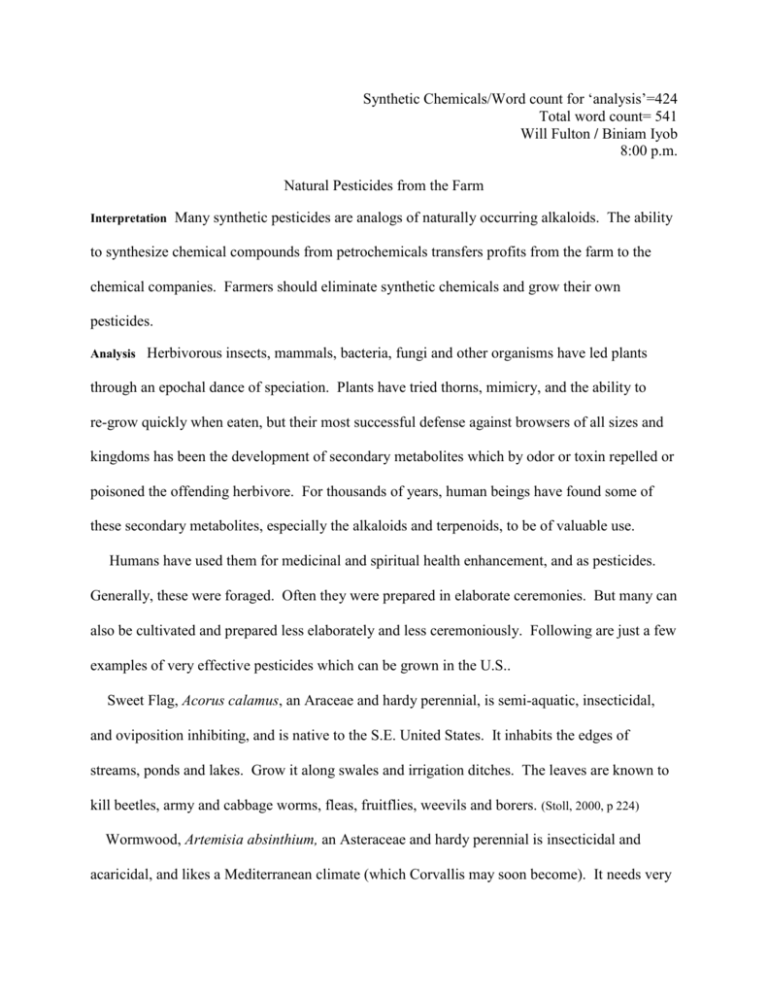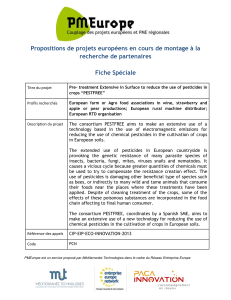Synthetic Chemicals/Word count for *analysis*=424/Total word
advertisement

Synthetic Chemicals/Word count for ‘analysis’=424 Total word count= 541 Will Fulton / Biniam Iyob 8:00 p.m. Natural Pesticides from the Farm Interpretation Many synthetic pesticides are analogs of naturally occurring alkaloids. The ability to synthesize chemical compounds from petrochemicals transfers profits from the farm to the chemical companies. Farmers should eliminate synthetic chemicals and grow their own pesticides. Analysis Herbivorous insects, mammals, bacteria, fungi and other organisms have led plants through an epochal dance of speciation. Plants have tried thorns, mimicry, and the ability to re-grow quickly when eaten, but their most successful defense against browsers of all sizes and kingdoms has been the development of secondary metabolites which by odor or toxin repelled or poisoned the offending herbivore. For thousands of years, human beings have found some of these secondary metabolites, especially the alkaloids and terpenoids, to be of valuable use. Humans have used them for medicinal and spiritual health enhancement, and as pesticides. Generally, these were foraged. Often they were prepared in elaborate ceremonies. But many can also be cultivated and prepared less elaborately and less ceremoniously. Following are just a few examples of very effective pesticides which can be grown in the U.S.. Sweet Flag, Acorus calamus, an Araceae and hardy perennial, is semi-aquatic, insecticidal, and oviposition inhibiting, and is native to the S.E. United States. It inhabits the edges of streams, ponds and lakes. Grow it along swales and irrigation ditches. The leaves are known to kill beetles, army and cabbage worms, fleas, fruitflies, weevils and borers. (Stoll, 2000, p 224) Wormwood, Artemisia absinthium, an Asteraceae and hardy perennial is insecticidal and acaricidal, and likes a Mediterranean climate (which Corvallis may soon become). It needs very well drained soil but makes few other demands, does well in full sun to partial shade, and is quite drought tolerant. Wormwood has been used for centuries as a moth repellant, general pesticide and as a tea/spray to repel slugs and snails. Epazote, Chenopodium ambrosioides, is an annual. The fruit contains substances toxic to corn weevil (Tavares, 2005, pp. 319-323). The plant is used as a fumigant against mosquitoes and is also added to fertilizers to inhibit insect larvae. ( Bown. D, 1995, p. 310 ) It propagates easily from seed, likes moderately fertile soils, full sun, and tolerates both salt and a pH range from 5.3 to 8.2. Neem, Azadirachta indica, is an insect growth regulator, which means that it abrupts metamorphosis, such that juveniles never become mating adults. It also has repellent, insecticidal, antibacterial, antifungal, and antifeedant qualities. (Prakash; Rao, 1997: pp. 35-103) It likes a much warmer climate than Corvallis has now. Ryania speciosa, is a shrub from South America. The principal alkaloid in this stem extract is ryanodine. It is highly toxic to the fruit moth, coddling moth, corn earworm, European corn borer, and citrus thrips, but it is ineffective against the cabbage maggot, cauliflower worm, and boll weevil. It is moderately toxic to humans, fish and birds, but very toxic to dogs. There are literally hundreds of others. Evaluation Inference Some of the work sourced is more anthropology than experimental science. Growing and preparing one’s own pesticides is labor intensive and therefore may only find practitioners among small family farms, but any decrease in the 4.6 billion pounds of synthetic pesticides America uses annually would be beneficial to the biosphere. Explanation The end of oil approaches. Those who rely on synthetic petrochemicals will lose profits. Farms must localize both their markets and their sources. Self regulation The author has a strong antipathy toward chemical companies. Bown, D., Encyclopedia of Herbs & Their Uses, DK Adult, London, 1995 Prakash, A.; Rao, J. (1997): Botanical pesticides in agriculture. CRC Press. USA Stoll, G. (2000): Natural protection in the tropics. Margraf Verlag. Weikersheim. Tavares MAGC, Vendramim JD (2005) Bioactivity of the Mexican-tea, Chenopodium ambrosioides L., towards Sitophilus zeamais Mots. (Coleoptera : Curculionidae). Neotropical Entomology 34, 319-23









